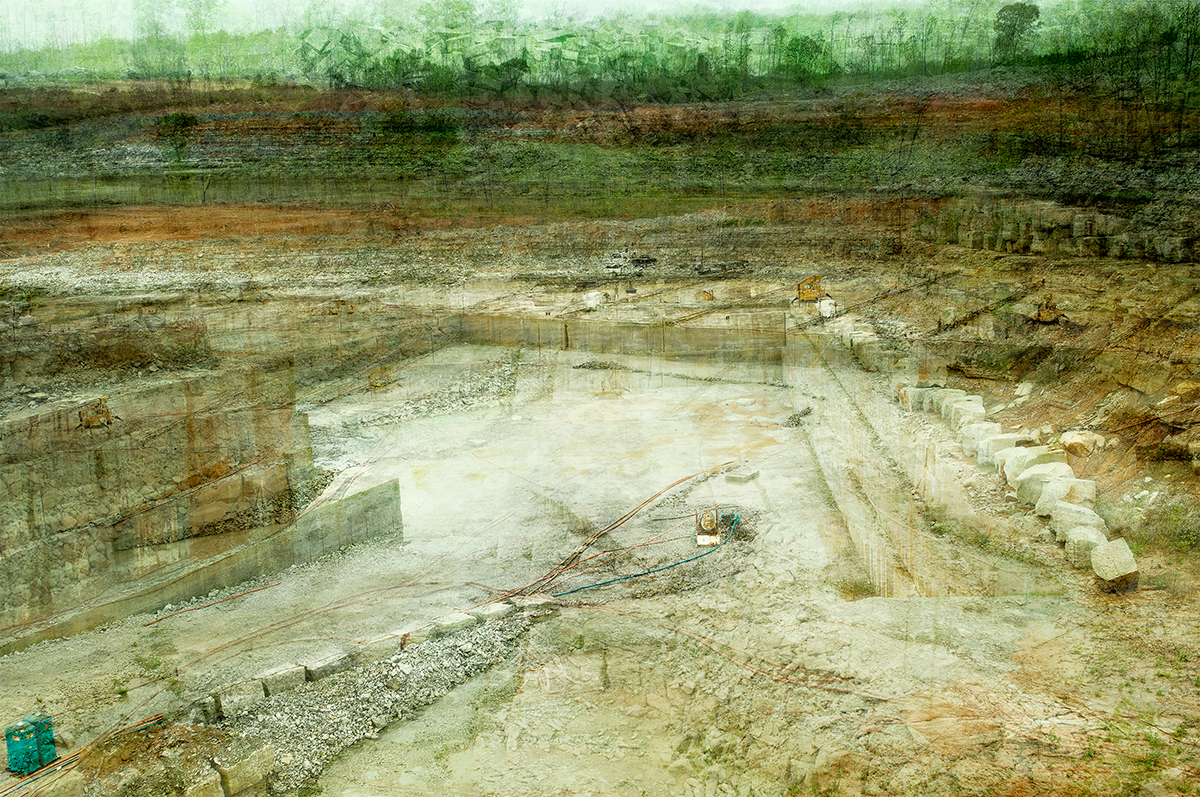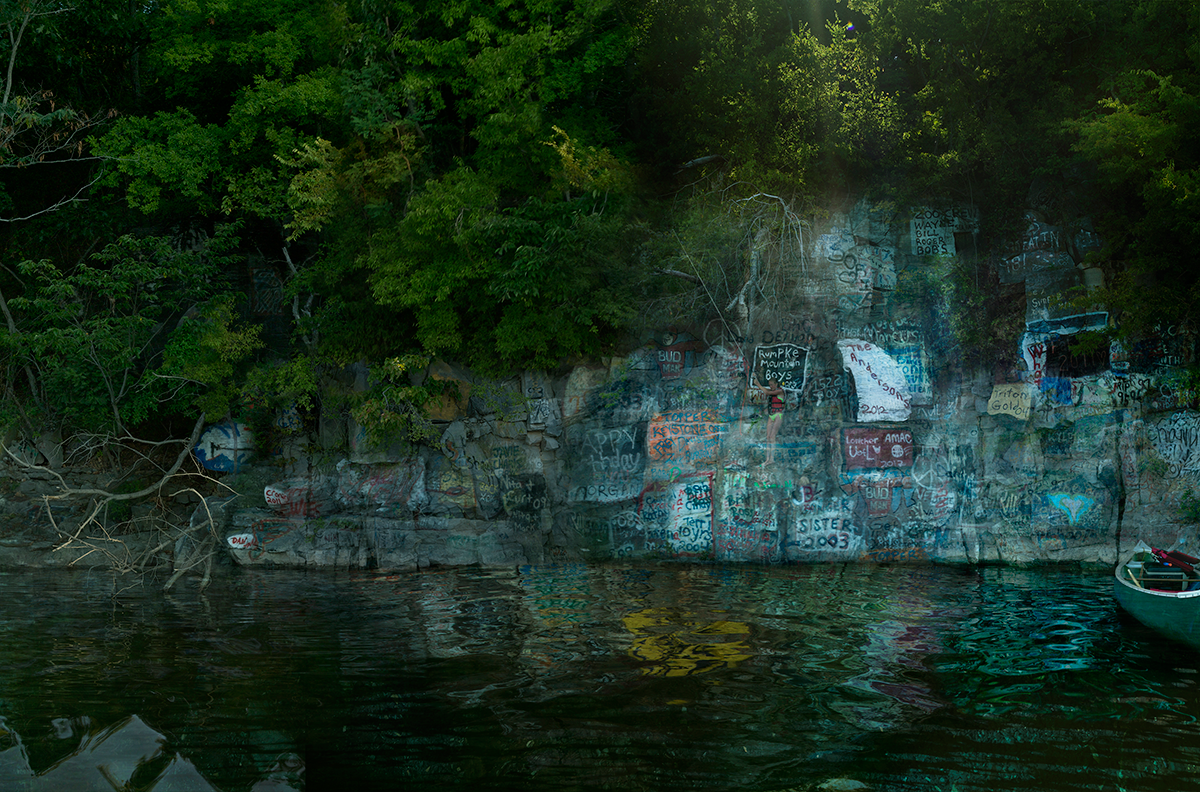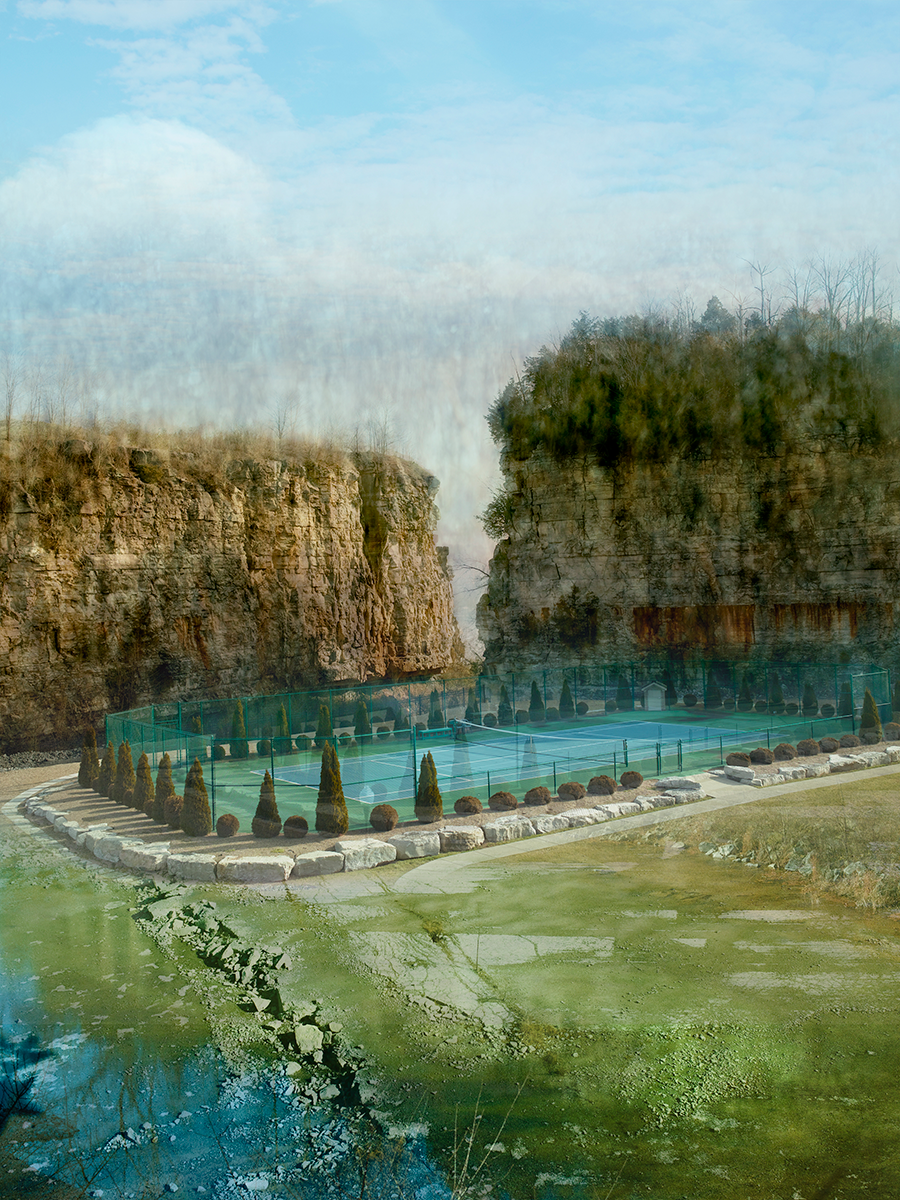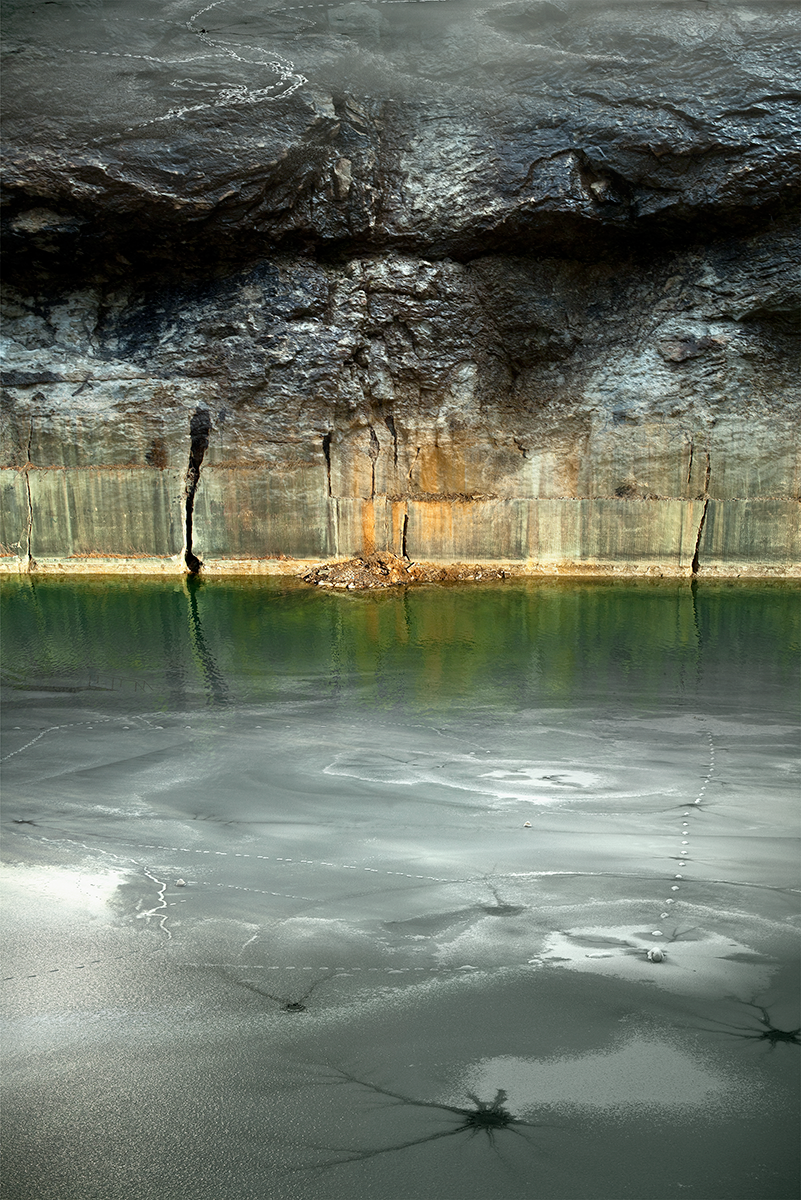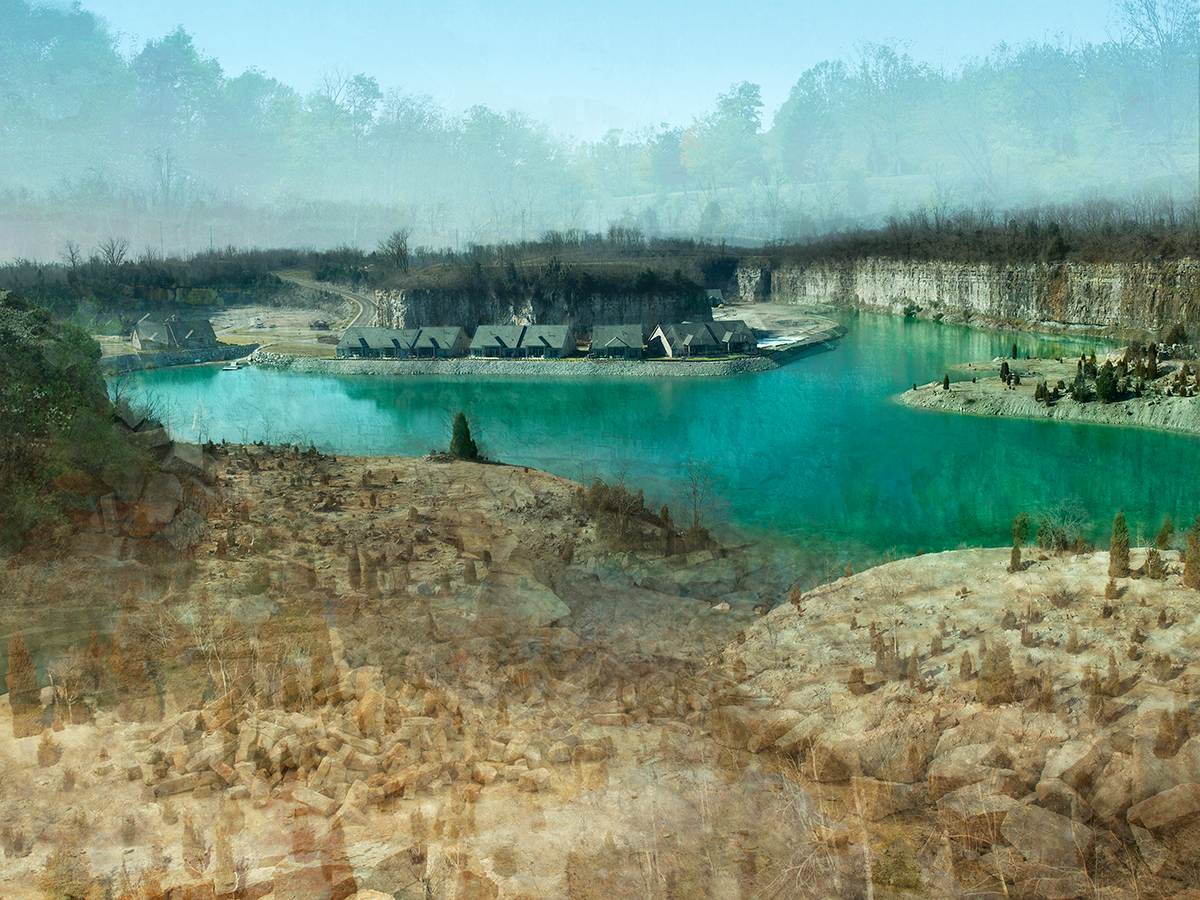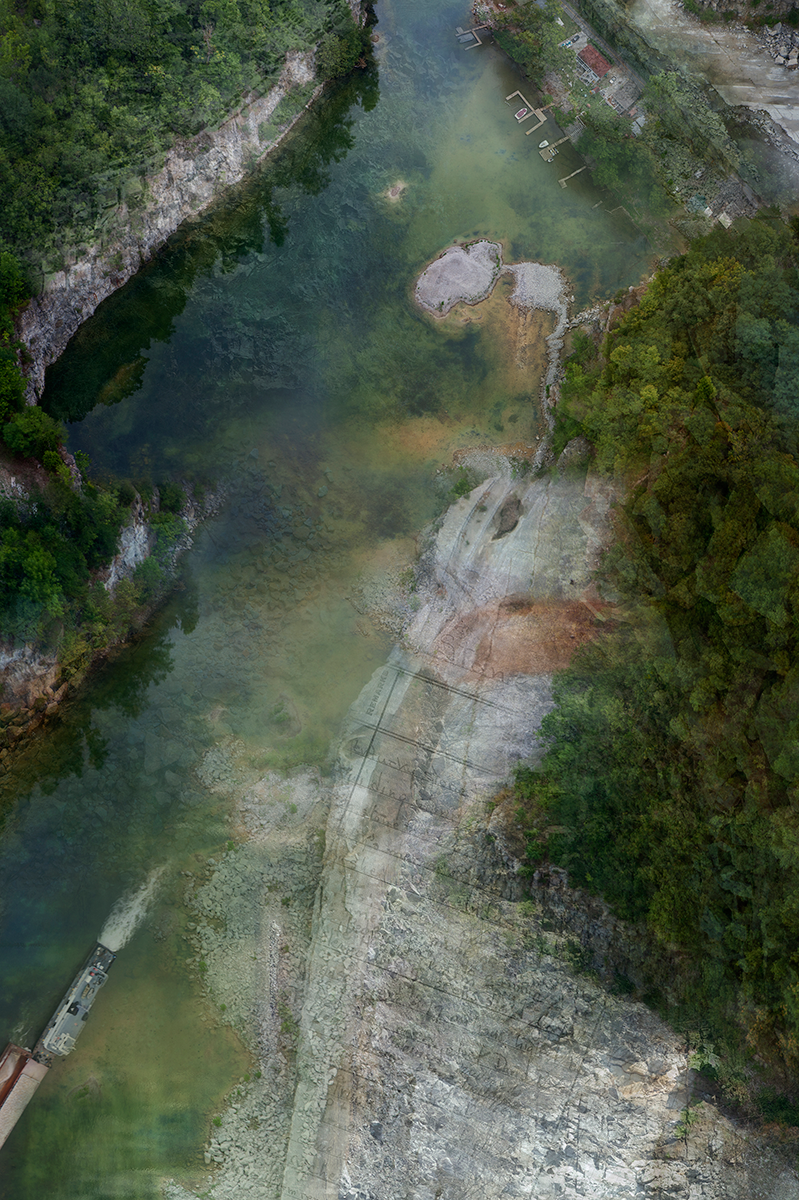In
the summer of 1867 American photographer Carleton Watkins hauled a
mammoth wooden camera through the wilderness of Oregon, taking
pictures of the mountains. To prepare each negative, he poured
noxious chemicals onto a glass plate the size of a windowpane and
exposed it while still wet, developing it on the spot. Even then, his
work was not complete. Because wet-plate emulsions are
disproportionately sensitive to blue light, his skies were
overexposed, utterly devoid of clouds. Back in his San Francisco
studio, Watkins manipulated his photos to resemble the landscapes
he’d witnessed. His finished prints were composites, embellished
with a separate set of cloud-filled negatives.
Nearly a century and a half later, Elena
Dorfman—another American photographer porting a large-format
camera—spent several summers in the rock quarries of Kentucky and
Indiana, landscapes as dramatic as Watkins’s Oregon. Dorfman had
none of the old limitations. Her digital Hasselblad instantaneously
captured 32-megapixel photos in full color. But it didn’t satisfy
her. In postproduction she created composites on her computer,
layering as many as 300 images to obtain effects unlike anything seen
in nature.
In one sense, Dorfman
was doing the opposite of what Watkins achieved with his library of
clouds. While his intervention made the mountain vistas more
meteorologically accurate, she
intentionally
introduced physical impossibilities,
from conflicting perspectives to rearranged geology, much
as a painter might fictionalize a scene. Yet
in another sense, each photographer was artfully striving for truth
about how we experience the natural world, laboring against the
inadequacies of the camera. For Watkins, the constraints were
physical. For Dorfman, they’re neurological, a discrepancy between
photomechanical depiction and how the brain processes what the eyes
perceive. Like many modern artists, she has a strong intuitive grasp
of how the visual brain works and understands that her pictures can
be made more stimulating by seeding them with conflicting
perspectives.
Examining Dorfman’s trickery—and the artifice
of other photographers from Weegee to David Hockney—provides a
valuable way of learning about how the brain handles contradictory or
uncertain visual information. Equally important, the neuroscience of
vision helps elucidate what makes these photographs so artistically
compelling. Enlisting photomanipulation, these photographers achieve
one of the most oft-praised qualities in art—ambiguity—in ways
that neuroscience is now beginning to understand.
Dorfman intentionally introduced physical impossibilities, much as a painter might fictionalize a scene.
In a 2004 paper titled Consciousness
and Cognition,
University College London neurobiologist Semir Zeki argued that the
brain experiences ambiguity as the “certainty of many, equally
plausible interpretations,” much like an optical illusion
alternately seen as approaching and receding. Zeki holds Johannes
Vermeer’s paintings as supreme examples of artistic ambiguity,
citing Girl with the Pearl Earring
to support his aesthetic judgment. “She is at once inviting yet
distant, erotically charged but chaste, resentful and yet pleased,”
he writes. And, as Zeki notes in his 1999 book,
Inner Vision,
Vermeer’s art is widely admired because the artist is able to
express all of that “in
a single profound painting, profound because it is so faithfully
representative of so much.”
Too bad Vermeer didn’t have a camera.
Photography may be more suited to capturing multiple conflicting
certainties than painting. A
painting can only blend visual information that has been preprocessed
by the unreliable brain. Each photograph, on the other hand, is an
independent fact. In
layering them without resolving their contradictions, as Dorfman
does, photographers approach the tenuous internal quality of truth.
On the surface,
photographic
ambiguity
is an oxymoron. The camera sees the
world with total fidelity to physical laws. It’s a deterministic
system, the performance of which can be perfectly predicted, given
the optics and the chemistry or necessary electronics. Human
perception is far messier, hacked together by a visual system riddled
with inconsistencies, as Zeki documents in Inner
Vision. Perception
is a product of evolution rather than engineering. Nobody thought out
in advance how all the parts would work together. It
isn’t really a system so much as a Rube Goldberg contraption where
the parts just manage to interact. For
instance, every eye has a blind spot where the optic nerve passes
through the retina, carrying signals to the brain, yet this blind
spot isn’t noticeable to the viewer. As National Institute for
Physiological Sciences neurophysiologist Hidehiko
Komatsu details in a 2006 Nature
Reviews Neuroscience review, the brain
fills in the blank in what is perceived by interpolating visual
information from areas of the retina surrounding the hole: The
resulting sight is an approximation.
In layering images without resolving their contradictions, photographers approach the tenuous internal quality of truth.
In fact, most everything about how we see comes
down to heuristics. In a 2005 Nature
paper, Harvard neuroscientist Patrick
Cavanagh observed that “our visual brain uses a simpler, reduced
physics to understand the world.” In other words, we aren’t using
all the complex mathematics of textbook optics to analyze the
relative position and characteristics of objects. We’re taking a
few imperfect cues and improvising. The visual information isn’t
totally accurate, but it’s good enough to get by and can be more
useful than perfect knowledge. (You don’t need to calculate the
velocity of a falling rock to know that you should step aside. In
fact, if you start making measurements from where you’re standing,
you probably won’t survive to complete them.)
Painters have an intuitive grasp of these
heuristics, taking visual shortcuts such as showing more of an object
than can be seen in a single glance or muddying insignificant
background details.
Those distortions
and uncertainties make their pictures less true to life but more true
to us: They reflect how we see. On
that basis, Cavanagh claimed that “artists act as research
neuroscientists,” informing us about how the brain works.
That may be inevitable for painters, since their
paintings derive from the perceptual apparatus of their own eyes and
brains. The heuristics of the mind guide the naive hand. The reduced
physics can be circumvented only with intense effort. For instance,
achieving unflawed one-point perspective, in which all objects recede
to a single vanishing point (like a converging set of railroad
tracks) requires rigorous training in overcoming the eyes’ constant
movement and refocusing. A geometrical system must be superimposed on
the canvas, and even Renaissance masters were notoriously hazy about
the correct projection of shadows. Photographers have the opposite
problem. One-point perspective comes in the box. The camera’s view
is too absolute. To be neuroscientific—and to
make pictures that resonate in painterly ways—photographers must
actively emulate the distortions and uncertainties inherent in vision
by purposely making their pictures deformed or ambiguous.
Distortions and uncertainties make their pictures less true to life but more true to us: They reflect how we see.
In 2006 MIT neuroscientist Pawan Sinha and
colleagues showed that faces with exaggerated features are more
immediately recognizable than straight depictions—despite being
less accurate—because they deviate more from average human
appearance. Paradoxically, you increase the intelligibility of the
image by decreasing the verisimilitude. Pablo Picasso instinctively
exploited this phenomenon by selectively distorting facial features,
intensifying the presence of portrait sitters such as Gertrude Stein.
In the mid-20th century, the American photographer Weegee applied a
similar tactic in his caricatures of public figures, including Lyndon
Johnson and Marilyn Monroe, whose features he twisted by physically
warping his negatives and using trick lenses. Johnson’s sloping
nose was obscenely elongated; Marilyn’s luscious lips were puffed
up to become positively lascivious.
Ambiguity has also taken cues from modern
painting. David Hockney, a painter by training, has revisited Cubism
with a camera in photo collages constructed from dozens of snapshots.
The snapshots are all close-ups of the same subject—say, a city
street or a swimming pool—each taken from a different angle and all
overlapped to render the contours of the original scene inexactly. As
in a Cubist painting, no single point of view can account for all the
visual information. Yet the ambiguity about where you’re standing
and the uncertain positioning of the scenery don’t make the image
confusing: They make it all-encompassing.
Visual research by Harvard neurobiologist
Margaret Livingstone and colleagues helps explain why Hockney’s
method works. When
we encounter an unfamiliar setting, our eyes dart around, acquiring
snapshots of everything in sight
before we begin to analyze what we’re seeing. This tactic maximizes
our acquisition of information before we know what we want to know
and prevents us from prematurely filtering out details that may later
prove important in terms of how we handle a crisis. But as a
consequence, each snapshot is independent. That means that, while
we’re looking, we aren’t aware of any inconsistencies between
images. Evolutionarily, noticing discontinuity simply wasn’t
important. As Livingstone and Wellesley College neuroscientist Bevil
Conway wrote in a 2007 review in
Current Opinion in Neurobiology,
“Perspective and reflections change second to second as we move our
eyes across a scene. Therefore, there would have been little
biological benefit to incorporating the rules for global perspective
or illumination into our visual computations.” Hockney’s photo-cubism embodies and
exploits our obliviousness to show us more than can possibly be
captured with the camera’s one-point perspective. We have the sense
of being right there with him.
When we encounter an unfamiliar setting, our eyes dart around, acquiring snapshots of everything in sight.
Dorfman’s layered photographs work on the brain
in a similar way, though they have less in common with Cubism than
with the post-Impressionist paintings of Paul Cézanne. Instead of
kaleidoscopically fragmenting the picture plane, Cézanne fused the
visual information gleaned from multiple disparate perspectives. In
his still lifes, for instance, a bowl of fruit might be shown at an
impossible tilt that allows you to see all the apples and
the bowl’s contact with the table. The reduced physics lets the
artist accentuate the scene’s essentials, even if his place of
observation is ambiguous. It’s a naive point of view, the
naturalness of which is proven by how commonly it’s found in
drawings by children.
In her most ambitious pictures, Dorfman takes
this power of synthesis to an extreme by transparently layering
scenes viewed from completely different directions or up close and at
a distance. In a single two-dimensional image, Dorfman presents the
visual information we’d glean by exploring a three-dimensional
landscape over many hours or days. Looking at one of her pictures, we
feel as if we’ve actually experienced
the place.
And in a sense, we have. Dorfman’s photographs
give us access to her experiences and her ambivalence toward a place
that’s at once beautiful and ruined. Through her photographs, we
feel her ambivalence. We don’t only observe
the multiple incompatible certainties that Zeki describes—we
internalize them.
Critic
and artist Jonathon
Keats
is most recently the author of Forged:
Why Fakes Are the Great Art of Our Age
(Oxford University Press).

























